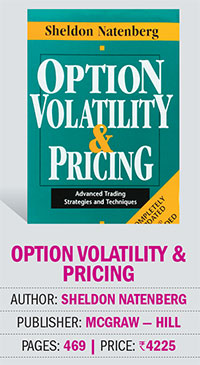
Sheldon Natenberg, in his famous book Option Volatility & Pricing, covers advanced trading strategies and techniques. He first published this book for professional traders but later, in the revised editions, he made changes that made the book useful even for those making an entry in the options segment.
The book, which runs into 469 pages across 18 chapters and explores key topics, finds an important place in the financial markets. A few chapters of the book discuss in detail the basics of option and futures. The book also throws light on volatility and its importance in option trading. In option pricing, volatility plays a key role. The author also explains the implied and historical volatility and implied versus future volatility in a simple manner, with detailed graphical representations. Along with time value and option Greeks, the book also delves on spreading with adequate examples. It reveals risks associated with option trading, various option arbitrage, hedging strategies and ‘position analysis’ and ‘models and the real world’. It lucidly explains the concept of synthetic relationship. Natenberg explains the various methods of graphing a position and also briefs on complex positions with several different strike prices.
The author started his career as an independent market-maker in equity options at the Chicago Board Options Exchange. While at his job, he has become active as an educator in the trade and has travelled across the globe and conducted seminars at major stock exchanges.
In the book, he tries to convey a basic tenet of option trading, that is, “Regardless of exact theoretical value, there ought to be a uniform progression of both individual option prices and spread prices in the marketplace. If this uniform progression is violated, a trader can take advantage of the situation by purchasing the option or spread, which is relatively cheap, and selling the option or spread, which is relatively expensive.”
He has suggested a few strategies with zero risk but an assured return. “Traders can identify potentially profitable trading strategies without the use of a theoretical pricing model. Consider the following option prices with the underlying price at 101.50. 95 call premium is $8.00, 100 call premium is $4.80 and 105 call premium is $1.60.
If the trader purchases one 95 call for $8.00, sells two 100 call at $4.80 and purchases one 105 for $1.60, the long butterfly for zero since: (2X4.80) – (8.00 + 1.60) = 9.60 – 9.60= 0. Since butterfly can never be worth less than zero at expiration, in this case, it might be worth as much as 5 points”.
In all, the author has made a considerable effort to enhance the quality of the book in the completely updated and expanded edition not only by explaining various concepts and models but also dealing with practical suggestions. This book can be useful to a layman, investor and also a professional trader.











